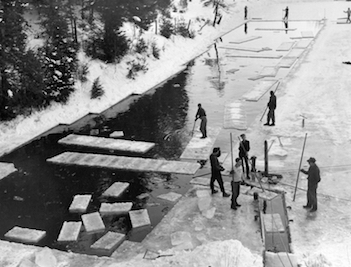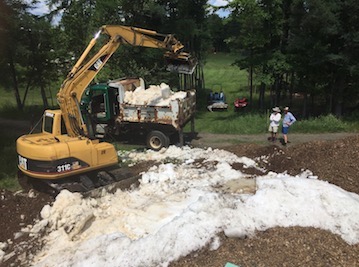What are we doing?
This project began in 2017 when Yves, Paul, Dick and Judy got to talking about how to make early season skiing
happen in these days of rapidly changing climate. All of us had seen snow stored over summer for fall skiing - but only high in the Alps of Europe or
near the poles in northern Sweden but never so far south as Vermont. Could we keep snow from
melting in a place where the summers
are so hot and sticky that your Ben and Jerrys becomes a puddle in minutes?
It was time to do some science and some engineering - could we, as a team of geologists, engineers, and ski area
professionals, make this happen? Then, we remembered. Vermont ice houses. Cut the ice off the lake in the winter,
cover it in saw dust, keep your food cold in the summer. Why not do the same for snow?


100 years apart. Cutting ice in Lyndon, Vermont and digging up stored snow for the Independence Day sledding party
In spring 2018, Hannah finished her undergrad degree and signed on for an MS in Natural Resources in close collaboration with Geology and Engineering. Soon after, Craftsbury created two small snow piles (30 dump truck loads of snow) and we monitored them all summer using lasers to measure how they shrank in the summer sun. We did all sorts of experiments, covering the the snow in wood chips, hard foam, soft foam, and space blankets. What did we learn? Covered right, snow can survive a hot, humid Vermont summer and make a lot of kids (young and old) happy skiing and sledding on the 4th of July. The science we did in 2018 told us what we needed to know to save snow "for real".
Fast forward - February 2019. Craftsbury fires up three new, high efficiency snow guns and fills an old leaky farm pond with 4 Olympic swimming pools worth of snow. After the snow was good and cooked by April warmth, we covered it with a foot of wood chips and then gave it a nice white blanket to reflect the sunlight and keep the snow cool. It worked, using the same laser surveying we used in 2018, we mapped the snow pile every two weeks. Slowly the snow settled and melted. In October, more than 60% of the snow we placed in the winter was still there. Game on!
Now, it's time to get the snow on the trails and start skiing.